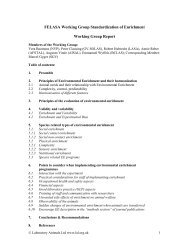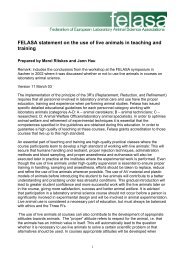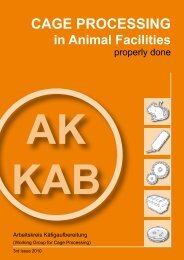CAGE PROCESSING in Animal Facilities - Felasa
CAGE PROCESSING in Animal Facilities - Felasa
CAGE PROCESSING in Animal Facilities - Felasa
- No tags were found...
You also want an ePaper? Increase the reach of your titles
YUMPU automatically turns print PDFs into web optimized ePapers that Google loves.
with r<strong>in</strong>se aid, for example, can be reused without affect<strong>in</strong>g the clean<strong>in</strong>g success. A f<strong>in</strong>al r<strong>in</strong>s<strong>in</strong>g, however,should always be done with pure fresh, dem<strong>in</strong>eralised water or with fresh dem<strong>in</strong>eralised water mixed withr<strong>in</strong>se aid.EnergyA flawless operation needs a certa<strong>in</strong> amount of energy. To keep this energy expenditure as low as possible, itis necessary to exploit all economically useful, state-of-the-art capabilities.Process chemicalsA constantly satisfy<strong>in</strong>g wash<strong>in</strong>g result requires a steady concentration of process chemicals dur<strong>in</strong>g the life ofoperation. To ensure an exact dispens<strong>in</strong>g of chemicals for the operator, manufacturers of washers and processchemicals offer a number of dispens<strong>in</strong>g devices up to centrally operat<strong>in</strong>g dispens<strong>in</strong>g stations. A chemicaloverdos<strong>in</strong>g would entail preventable environmental pollution, an underdos<strong>in</strong>g a poor wash<strong>in</strong>g or r<strong>in</strong>s<strong>in</strong>g result.Process chemicals must be developed from resources that ensure a best possible sav<strong>in</strong>g of the environment.Depend<strong>in</strong>g on the characteristics of the soil<strong>in</strong>gs to be elim<strong>in</strong>ated, detergent solutions can have an acid to alkal<strong>in</strong>epH range. R<strong>in</strong>se aids usually have a mildly acid pH value.The most important <strong>in</strong>gredients of process chemicals are:AlkalisAlkalis contribute to the wash<strong>in</strong>g process by expand<strong>in</strong>g and remov<strong>in</strong>g organic soil residues, like starch, prote<strong>in</strong>,and fat. This leads to a high (alkal<strong>in</strong>e) pH value of the detergent solution. In the <strong>in</strong>ternal dra<strong>in</strong>age system ofa facility, however, alkalis are diluted by be<strong>in</strong>g mixed with other, <strong>in</strong> part acid waste water. Thus, the pH value ofthe wash<strong>in</strong>g waste water will be reduced to the limit value commonly def<strong>in</strong>ed <strong>in</strong> Sewage Law. If this is not thecase, a neutralis<strong>in</strong>g system should be built <strong>in</strong>.PhosphatesPhosphates b<strong>in</strong>d the water’s hardness components and contribute to the wash<strong>in</strong>g process by their emulsify<strong>in</strong>gand dispers<strong>in</strong>g effect. Beside <strong>in</strong>organic nitrogen compounds, phosphates are among the most important nutrients<strong>in</strong> water. Excessive phosphate supply will lead to an <strong>in</strong>tensified bio production (overfertilisation). In sewageplants with a precipitation level (3 rd level) phosphates are widely elim<strong>in</strong>ated.Phosphate substitutesPhosphate substitutes can replace real phosphates only here and there. Just as real phosphates, they areused for b<strong>in</strong>d<strong>in</strong>g water hardness. However, the use of substitutes for this purpose cannot be fully recommendeddue to ecological objections, like their lack of biodegradable properties.Active chlor<strong>in</strong>e carrierActive chlor<strong>in</strong>e is used for reduction of organisms and oxidative decomposition of organic residues. As activechlor<strong>in</strong>e, due to its property of generat<strong>in</strong>g AOX, is rated as pollutive, its use is more and more abandoned.SurfactantsSurfactants reduce the surface tension of the detergent solution or r<strong>in</strong>s<strong>in</strong>g water and must be biodegradable,which means they are degraded <strong>in</strong> a sewage plant with help of microorganisms.AcidsInorganic or organic acids <strong>in</strong> acid detergents help remove m<strong>in</strong>eral residues. R<strong>in</strong>se aids b<strong>in</strong>d the residual hardnessof r<strong>in</strong>s<strong>in</strong>g water and prevent deposits of calcium. The use of acids leads to a low (acid) pH value of thedetergent solution. In the <strong>in</strong>ternal waste water system of a mach<strong>in</strong>e or facility, however, acids are diluted bybe<strong>in</strong>g mixed with other waste water. Thus, the pH value of the wash<strong>in</strong>g waste water will be neutralised to thelimit value commonly def<strong>in</strong>ed <strong>in</strong> Sewage Law. If this is not the case, a neutralis<strong>in</strong>g system should be built <strong>in</strong>.Trad<strong>in</strong>g unitTrad<strong>in</strong>g units of process chemicals should be made of plastics (like PE or PP) that help save the environment asbest as possible. Before dispos<strong>in</strong>g used units, they must be completely emptied of residues. A frequent dispos<strong>in</strong>gof empty plastic units can be prevented by us<strong>in</strong>g large refillable units.Cage Process<strong>in</strong>g <strong>in</strong> <strong>Animal</strong> <strong>Facilities</strong> · 4th issue · 2013 59






